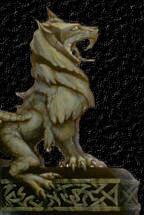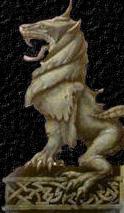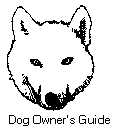











"Excuse me, but what kind of dog is that? He looks just like a big bear!"
Chances are, the questioner has just met an Akita, the National Dog of Japan.
Akitas are most striking and impressive creatures with an attitude of nobility and an appearance of strength and power. Their most noticeable physical characteristic is a large, bear-like head with erect, triangular ears set at a slight angle following the arch of the neck. They have thick, stand-offish coats, and tight cat feet, well knuckled up. Their tails curl over the top of the back in a graceful sweep down the loin, into a gentle curl, or into a double curl. Their colors are rich and clear, like paint on a canvas.
Mature males measure at least 25 inches at the withers and weigh more than 100 pounds. Mature females measure at least 23 inches and weigh approximately 80 pounds.
Recognized by the American Kennel Club in 1973, the Akita is a rather new breed in the United States. It has grown steadily in popularity, in part because of its extraordinary appearance and in part because of its captivating personality.
The Akita character is the result of centuries of breeding in Japan. Japanese history, both verbal and written, describe the Akita as one of the oldest of the native dogs. Centuries ago the breed was owned only by the Shogun, the imperial leaders of the country. The Akita developed in the Akita prefecture, the northernmost region of the island of Honshu. Bred to hunt, guard, and herd, this swift, agile, unswervingly tenacious dog tracked large game and held it at bay until the royal hunters arrived to make the kill. The Akita's quarry included elk, antelope, boar, and the 800-pound Yezo bear.
As a guard dog, the Akita was unsurpassed in its keen senses of smell, sight, and hearing. By nature a quiet dog that barked only when threatened, the breed needed no training in its guard duties. As a herding dog, it fiercely protected livestock from savage predators in the mountainous terrain of Akita Prefecture.
During the late 1800s, the Akita breed suffered two major setbacks. First, the Akita was crossed with the Japanese fighting dog, the Tosa. This crossbreeding resulted in a dog of imposing size and aggression used extensively when dog fighting was a popular sport in Japan. Then, at the turn of the century, Japan had a fatal outbreak of rabies with more than 3000 cases reported. Dogs, both healthy and affected, were clubbed to death.
However, three events focused positive attention on the breed in the early 1900s.
First was the story of Hachi-Ko, one of the most revered Japanese Akitas of all time. He was born in 1923 and was owned by Professor Eizaburo Ueno of Tokyo. Professor Ueno lived near the Shibuya Train Station in a suburb of the city and commuted to work every day on the train. Hachi-Ko accompanied his master to and from the station each day.
On May 25, 1925, when the dog was 18 months old, he waited for his master's arrival on the four o'clock train. But he waited in vain; Professor Ueno had suffered a fatal stroke at work. Hachi-Ko continued to wait for his master's return. He traveled to and from the station each day for the next nine years. He allowed the professor's relatives to care for him, but he never gave up the vigil at the station for his master. His vigil became world renowned, and shortly after his death, a bronze statue was erected at the train station in his honor. Then, in 1931, The Akita was officially declared a Japanese National Monument. The Mayor of Odate City in the Akita Prefecture organized the Akita Inu Hozankai to preserve the original Akita as a national treasure through careful breeding.
The third positive event was the arrival of Helen Keller in Japan in 1937. She expressed a keen interest in the breed and was presented with the first two Akitas to enter the US. The first dog died at a young age, but the second became Keller's constant companion until his death in 1945.
However, just as the breed was stabilizing in its native land, World War II pushed the Akita to the brink of extinction. Early in the war the dogs suffered from lack of nutritious food. Then many were killed to be eaten by the starving populace, and their pelts were used as clothing. Finally, the government ordered all remaining dogs to be killed on sight to prevent the spread of disease. The only way concerned owners could save their beloved Akitas was to turn them loose in the most remote mountain areas. There the breed's hardiness and keen hunting instincts helped them survive the war years.
During the occupation years following the war, the breed began to thrive again. US servicemen fell in love with the Akita and smuggled many of them into the US when they returned.
The Akita today is a unique combination of dignity, courage, alertness, and devotion to its family. It is extraordinarily affectionate and loyal with family and friends, territorial about its property, and aloof with strangers. It is feline in its actions; it is not unusual for an Akita to clean its face after eating, to preen its kennel mate, and to be fastidious in the house.
Because it is a large dog, the Akita is certainly not a breed for everyone. Its personality is that of a survivor. Even though centuries have passed since the Shogun warrior owned Akitas, the breed still exhibits keen hunting prowess, extraordinary strength and endurance, and the ability to survive on its own. Akita owners must channel these attributes into early obedience training so that their dogs become good canine citizens rather than neighborhood bullies.
The Akita learns quickly and can become bored easily. Those who don't understand the breed often describe it as stubborn, when in fact, the dog is exhibiting improper training. The Akita thrives on the love and respect of its master and, with constant reinforcement training and a little creativity, can be a very good worker.
The Akita was never bred to live or work in groups like many hound and sporting breeds. Instead, they lived and worked singly or in pairs, a preference reflected today. The individual Akita is happy being an only dog or one of two dogs in a household, but can be very aggressive towards animals not part of his family group, particularly strange dogs. A properly trained Akita will learn to tolerate other animals and not go looking for trouble, but the owner must never forget his dog's inherent drive to be top dog at almost any cost.
There are many pluses to owning an Akita. They are affectionate to their owners and are excellent watchdogs, although they do not bark unless something is amiss. They require only moderate exercise, adjust well to apartment living as long as they receive daily walks, do not eat large quantities of food, and are long-lived. Negatives to ownership include a twice-a-year shedding of the thick, downy undercoat; the size and strength of the breed which, if not properly managed, can become a nightmare; and the predisposition to be aggressive to other dogs, when they are not trained at young age
